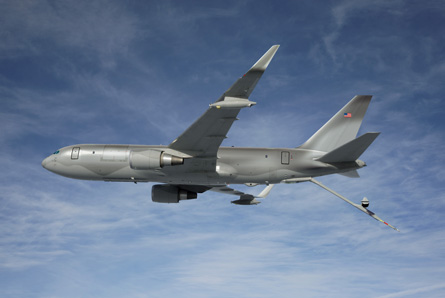Boeing's proposed KC-767 NewGen Tanker for the US Air Force incorporates the wing and fuselage from the 767-200, the cargo door and floor from the 767-300F and the cockpit from the 767-400ER.
The offering, which is currently being evaluated by the USAF along with the EADS North America KC-45 for an initial 179-aircraft requirement, will also feature a new boom. NewGen Tanker programme manager Jean Chamberlin says the new boom will have "a wider envelope than the KC-10 and is fully digitalised". She declines to provide more details for proprietary reasons but says it will "absolutely" be developed in time for initial operating capability in 2017.
The new boom is the biggest difference between the NewGen Tanker and the four delayed KC-767 tankers that Boeing is now preparing to deliver to Italy. "Boeing and the Italian air force will seek to deliver the first two KC-767s by the end of this year," the company says.
Chamberlin, speaking to Flightglobal after addressing employees at a 27 September rally in Everett to promote the NewGen Tanker programme, also confirms that the tanker's cockpit will feature four large Rockwell Collins displays similar to those on the 787 and also now installed on the 777 and 767-400ER.
 |
|---|
© Boeing |
The latest technologies will also be incorporated at the operator station, where Chamberlin says there will be a "three-dimensional view". She says the NewGen Tanker will also feature a "computer-aided boom that allows you to ensure alignment". It will be able to "refuel any aircraft in the inventory of the US government and many of our foreign allies".
Chamberlin declines to discuss fuselage and wing specifications. But another Boeing source says the NewGen Tanker will have a 159ft (48.5m) wingspan and 156ft fuselage length, matching the footprint of the 767-200. The aircraft will borrow the cargo door and floor rollers from the 767-300F.
The source says Boeing decided against incorporating the fuselage and wing from the larger 767-300 to give the USAF more flexibility in operating into smaller airfields. The company believes the 767-200 is ideal for meeting the service's requirement for "best performance and smallest footprint".
Boeing marketing documents illustrate as an example the tight ramp at Royal Air Force base Akrotiri in Cyprus, which was used during Operation "Desert Storm". Boeing claims this can accommodate only six Airbus A330-200-based KC-45 tankers, or nine KC-767 NewGen Tankers at one time. Although each A330 can carry more fuel, the total amount of fuel and passengers that can be carried with a mission at Akrotiri is higher with the Boeing solution.
Boeing chief executive Jim Albaugh told the rally the NewGen Tanker will be able to operate into twice as many airfields as the A330. Its claimed superior fuel efficiency will also result in savings that according to Washington Congressmen Norm Dicks will amount to $25 billion to $30 billion over 40 years.
Albaugh says he expects a decision from the USAF, which has been reviewing Boeing's NewGen Tanker proposal since July, in late November or early December. While the initial requirement is only for 179 KC-135 replacements, he estimates Boeing will ultimately produce 400 to 500 NewGen Tankers for the USAF and "air forces around the world".
Chamberlin says Boeing has already begun preparations to ensure it can deliver 18 aircraft in 78 months after the winning bid is selected. She says the manufacturer is "laser-focused for day one" and will be ready to start producing 767-based tankers for the USAF "when the clock starts".
Boeing, which has been promoting its NewGen Tanker through a road show that has seen its demonstrator visit 26 locations since March, estimates a USAF contract will support 11,000 jobs in the state of Washington and generate $693 million in annual economic impact.
Source: Flight International























